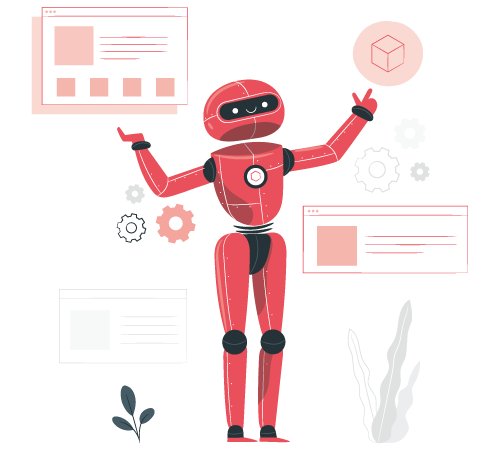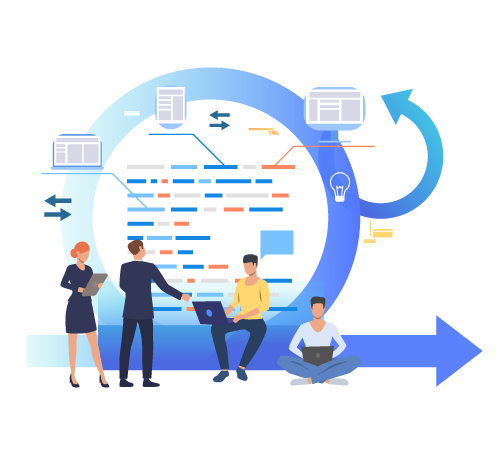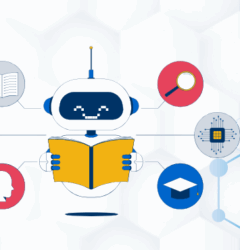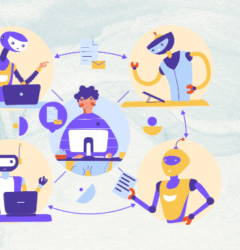
But what’s all the fuss about hyperautomation, and why has Gartner classified it as a top strategic technology trend?
To answer these questions, we will have to dig deep, but let’s start from the basics –
What is Hyperautomation?
In simple words, it refers to continuous automation in business. When you keep integrating automation into your operations, you hyper-automate. It is an advanced-level step in the process of digital transformation.
Now, let’s speak the Gartner language and see what their definition of hyperautomation is – Business-driven hyper-automation refers to an approach in which organizations rapidly identify, vet, and automate as many approved business and IT processes as possible through a disciplined approach. Hyperautomation involves the orchestrated use of multiple technologies, tools, or platforms (inclusive of, but not limited to, AI, machine learning, event-driven software architecture, RPA, iPaaS, packaged software, and other types of decision, process, and/or automation tools.)
By 2026, the hyperautomation market will reach $1.04 trillion, driven by the need for digital transformation, talent shortages, and rising competition.

So, isn’t hyper-automation just like automation? It might feel like it, but there’s a significant difference between the two. Automation is limited to simple optimization. Hyperautomation is advanced because it comes with more intelligence to ensure that the whole process is much smarter than before.
The intelligence may come from AI in different forms, such as optical character recognition and natural language processing.
Also read: A Complete Guide to Workflow Automation Software
Will Hyperautomation replace human jobs?
We will answer this with a simple quote –
Robots aren’t here to take away our jobs. They are here to give us a promotion.
Manjunath Bhat (Research Director, Gartner)
This is a looming fear among all individuals. Hyperautomation utilizes AI for smart operation. So, does that mean that it will take away human jobs? Absolutely not. It will only optimize human ability. It is not here to replace it.
Getting started with hyperautomation
Hyperautomation is an unavoidable market state in which organizations must rapidly identify and automate all possible business processes
Gartner
So, the sooner we start, the better. But how?
Businesses must first start investing in the right tools and technologies because, at the crux, this is what hyper-automation is all about. Which tools you select will determine how the entire process goes. So, we suggest that you pick something scalable, easy to integrate, seamless, and easy to use.
Key elements of hyperautomation
Let’s expand on the aforementioned point of choosing the right tools and speak in detail about the must-dos for hyper-automation. The key elements, according to us, are:
1. Artificial intelligence (AI)

AI includes machine learning, natural language processing, intelligent optical character recognition, and similar processes. They work to augment the entire supply chain. With the help of AI, businesses can automate all time-consuming, tedious, and repetitive processes. Because AI is smart enough to recognize voices and faces, you can use it for numerous tasks.
Integration of AI is one of the most crucial steps for hyper-automation.
Also Read: 8 Real-World Examples of Agentic AI: From Hype to Measurable Results
2. Event-driven software such as RPA, iPaaS, iBPMS
This includes robotic process automation, iPaaS, iBPMS, etc. This software will handle data migration even when the APIs are not compatible. RPA, for example, will manipulate data. iBPMS, on the other hand, empowers citizen developers to collaborate with machines and successfully form a technological infrastructure.
3. Conversational process automation
Chatbots use cognitive intelligence and respond to users based on their emotional state. When integrated with RPA, this form of automation can be powerful enough to resolve most issues without human intervention.
Expect that everything that can and should be automated will be automated, rightly or wrongly
Gartner
Using the aforementioned technologies, we are positive you will be able to do it rightly.
Also read: BPM and BPA: What’s the difference, and which do you need?
Why Is Hyper-automation Important?
Hyperautomation is crucial because it empowers organizations to achieve unprecedented levels of operational efficiency, agility, and innovation. By combining advanced technologies like RPA, AI, ML, and no-code/low-code platforms, hyper-automation streamlines processes, reduces errors, and frees employees from repetitive tasks. It enhances decision-making through data analytics and accelerates digital transformation efforts. In an increasingly competitive and fast-paced business landscape, hyper-automation is essential for staying competitive, improving customer experiences, and adapting to rapidly evolving market demands.
Benefits of Hyper-automation
It all seems great in theory, but what are the real benefits organizations can enjoy through hyper-automation? List below is the advantages of hyperautomation:
1. Workforce empowerment
When all repetitive and tedious tasks are automated, employees are free to work on productive tasks without worrying about mundane tasks. The workforce will be completely focused on the super-important tasks while hyper-automation takes care of the rest of the processes.
- Example: A customer service department uses AI-powered chatbots to handle routine inquiries. This frees up human agents to focus on complex customer issues and provide a more personalized experience, leading to higher customer satisfaction scores.
2. ROI
Hyperautomation gives organizations access to analytics data, which is very important for ROI. Businesses can learn from the data and find out which initiatives are making money. They can then iterate and optimize to get a better ROI.
- Example: A retail company utilizes a No-Code app builder to develop a custom inventory management system. By integrating the app with their existing sales and supply chain software, they streamline inventory tracking and order fulfillment processes. This results in improved inventory accuracy, reduced stockouts, and enhanced customer satisfaction due to faster order processing and delivery times.
3. Business agility

When businesses are agile, they scale and grow without constraints. Hyperautomation enables such agility through AI.
- Example: A manufacturing company implements hyperautomation in its supply chain management. This allows them to react more quickly to disruptions and optimize inventory levels, leading to increased responsiveness and improved customer delivery times.
Also Read: AI Agents vs Chatbots vs Virtual Assistants: A Practical Breakdown for Decision Makers
4. Upskilling
Through hyper-automation, you can create a culture of upskilling and expert-level support. With all mundane tasks being taken off their to-do list, employees can handle various activities and upskill in the process.
- Example: A hyperautomation initiative requires employees to learn new skills in working with AI and automation tools. This upskilling process creates a more adaptable workforce and fosters a culture of innovation.
5. Integrations
Seamless integration between cloud and on-premise infrastructure improves communication and reduces lag. All systems will be able to access the centralized data, which means that they will be on the same page. This will help them improve their efficiency.
- Example: A retail company uses hyperautomation to seamlessly integrate their point-of-sale system, inventory management software, and marketing automation platform. This allows them to personalize customer offers in real time based on purchase history and preferences, leading to increased sales and customer loyalty.
Also read: What Processes Every Business Must Automate?
Common challenges of Hyperautomation
Any new approach introduced in the regular working of business face challenges in the beginning, and hyper-automation is no exception. Some of the challenges of hyper-automation includes
- Poor quality of data and lack of resources/technical skill shortage prevent businesses from tackling automation efforts.
- There are n number of automation software available in the marker. It becomes difficult for businesses to choose the one that fits the best. For example, a no-code tool can be helpful if businesses have customized processes.
While hyperautomation holds immense promise, it comes with its own set of challenges that organizations must navigate to unlock its full potential. One of the primary hurdles is the complexity of integration. As businesses adopt a multitude of automation tools—ranging from RPA to AI to low-code platforms—ensuring seamless interoperability between legacy systems, cloud environments, and modern applications becomes increasingly difficult. Inconsistent data formats, siloed systems, and fragmented workflows can hinder the end-to-end automation vision.
Scalability is another concern. Automating isolated tasks is relatively straightforward, but scaling those automations across departments and processes requires robust governance, infrastructure, and strategic oversight. Without a clear roadmap, businesses risk creating automation silos that add to operational chaos instead of reducing it.
Data quality also poses a significant barrier. Hyperautomation relies heavily on data-driven decision-making, and inaccurate, incomplete, or outdated data can severely impact the effectiveness of automated systems. AI and ML models, in particular, need clean and well-structured data to function optimally. Ensuring high data quality demands continuous monitoring, cleansing, and validation mechanisms, which can be resource-intensive.
Additionally, the rapid evolution of automation technologies can outpace organizational readiness. Skills gaps among employees, resistance to change, and a lack of understanding of automation tools often slow down implementation efforts. While low-code/no-code platforms mitigate some of these issues by simplifying development, fostering a culture of innovation and continuous learning is still essential to keep pace.
Security and compliance risks are also amplified. Automating processes at scale introduces new vulnerabilities—especially when sensitive data is involved. Organizations must enforce strict access controls, audit trails, and real-time monitoring to maintain trust and meet regulatory requirements. Without a comprehensive risk management strategy, automation can inadvertently expose businesses to compliance breaches and cyber threats.
Ultimately, the success of hyperautomation depends not just on technology adoption but on the organization’s ability to align people, processes, and platforms toward a shared automation vision.
Difference between Automation vs Hyperautomation
Think of automation as a helpful robot that can take care of specific tasks for you. It’s like having a little assistant that follows a set of instructions to do things without you having to do them manually. For example, if you have a robot vacuum that cleans your floors on its own, that’s automation in action.
Now, hyperautomation takes this idea and supercharges it. Imagine your helpful robot not only doing one task, but it’s also able to learn, adapt, and take care of a whole bunch of different tasks, even the really complex ones. It’s like upgrading that robot vacuum to not just clean, but also organize your stuff, water your plants, and even remind you when you’re low on groceries.
In simpler terms, automation is like a focused task-doer, while hyperautomation is like having a super-smart multitasker that can handle a bunch of things at once. It uses advanced technologies like artificial intelligence and machine learning to make it happen.
Hyperautomation is the #1 Gartner Top 10 Strategic Technology Trends for the year 2020. Hyperautomation will take automation to the next level, enabling organizations to function faster, better, and smarter. Make sure you choose the right tools to establish it in your organization because its success heavily depends on the choices you make.

How to Get started with hyper-automation
To kickstart hyper-automation, follow these steps:
- Assessment: Identify and prioritize processes for automation, considering complexity and impact.
- Define Goals: Clearly state your automation objectives, like cost reduction or efficiency improvement.
- Choose Tools: Select automation tools, including no-code platforms, RPA, AI, and ML.
- Build a Team: Assemble a skilled team of analysts, developers, and automation specialists.
- Analyze Processes: Map existing workflows and identify inefficiencies.
- Design Automation: Create a roadmap for implementation, starting with no-code solutions for simple tasks.
- Implementation: Deploy no-code, RPA, and AI/ML solutions, ensuring seamless data integration.
- Testing: Rigorously test automation solutions.
- Training: Train staff to work alongside automation tools.
- Monitor and Optimize: Continuously track performance and refine processes.
- Scale Up: Expand automation to other areas.
- Compliance and Security: Ensure regulatory compliance and robust security.
- Continuous Learning: Stay updated with new automation tech and best practices for ongoing success.
Remember that hyper-automation is an ongoing journey, and it’s crucial to adapt and refine your approach as you gain experience and encounter new opportunities for automation within your organization.
Also Read: AI Automation 101: What It Is & How Businesses Are Using It
Industries that can benefit from Hyper-automation
Hyperautomation has the potential to benefit a wide range of industries by enhancing efficiency, reducing costs, and improving decision-making. Here are some industries that can significantly benefit from hyper-automation:
1. Healthcare
- Automated Patient Intake: Bots can streamline patient registration, appointment scheduling, and insurance verification, reducing administrative burden and improving patient experience.
- Medical Diagnosis Support: AI-powered tools can analyze medical images and assist doctors in early disease detection and treatment planning.
2. Finance & Banking
- Fraud Detection and prevention: Machine learning algorithms can analyze transaction patterns to identify and prevent fraudulent activities in real-time.
- Loan Processing: AI ML automates loan application review, document verification, and credit scoring, leading to faster loan approvals.
3. Retail
- Demand Forecasting: Predictive analytics can forecast customer demand and optimize inventory levels, reducing stockouts and overstocking.
- Personalized Customer Recommendations: AI chatbots can recommend products based on customer purchase history and browsing behavior, leading to increased sales and customer satisfaction.
4. Manufacturing
- Predictive Maintenance: IoT (Internet of Things) sensors and machine learning can predict equipment failures and schedule preventive maintenance, minimizing downtime and production losses.
- Quality Control Automation: Machine vision systems can automate visual inspection of products, ensuring consistent quality and reducing human error.
5. Insurance
- Automated Claims Processing: AI ML automates data extraction from claim forms and integrates with insurance systems for faster and more accurate claim settlements.
- Risk Assessment & Underwriting: Machine learning models can analyze past claims data and customer information to personalize risk assessments and insurance premiums.
6. Customer Service
- Automated Chatbots & Virtual Assistants: AI-powered chatbots can handle routine customer inquiries, freeing up human agents for complex issues and providing 24/7 customer support.
- Sentiment Analysis: Text analytics tools can analyze customer feedback and social media conversations to identify satisfaction levels and areas for improvement.
7. Human Resources
- Recruitment Automation: AI ML automates resume screening and candidate scheduling, streamlining the recruitment process.
- Onboarding Automation: Automated workflows can handle new employee onboarding tasks like document collection and benefits enrollment, saving time and reducing errors.
These are just a few examples, and hyper-automation applications continue to evolve across various industries. By strategically implementing hyper-automation, businesses can unlock significant improvements in efficiency, accuracy, and customer experience.
Key Technologies of Hyperautomation
Hyperautomation is the strategic approach of combining multiple advanced technologies to rapidly identify, automate, and optimize business and IT processes at scale. At its core, hyperautomation integrates artificial intelligence (AI) and automation platforms to move beyond siloed task automation and toward end-to-end intelligent automation. According to Gartner, hyperautomation is driven by the convergence of AI, machine learning (ML), robotic process automation (RPA), and a growing suite of enabling technologies that together unlock automation for complex and unstructured processes.
Organizations are increasingly turning to this integrated ecosystem of tools to not only automate manual tasks but to orchestrate decision-making, improve agility, and accelerate digital transformation. Below are the key technologies that power hyperautomation:
1. Process Discovery and Process Mining
Process discovery technologies, powered by AI, ML, and natural language processing (NLP), enable organizations to uncover how work is actually done. These tools map workflows by capturing digital footprints left behind in systems and applications, identifying inefficiencies, deviations, and automation opportunities. Process mining further analyzes this data to surface patterns, bottlenecks, and compliance risks. Together, they provide the foundation for data-driven automation strategies by highlighting where automation will deliver the most value.
2. Robotic Process Automation (RPA)
RPA is a foundational component of hyperautomation. It mimics human actions across digital interfaces to execute repetitive tasks such as data entry, reconciliation, and transaction processing. Modern RPA platforms integrate seamlessly with AI models to extend automation to processes involving unstructured data. When scaled with governance and orchestration, RPA becomes a powerful tool for enterprise-wide automation, enabling consistent execution across thousands of bots.
3. Artificial Intelligence (AI) and Machine Learning (ML)
AI technologies empower hyperautomation by introducing cognitive capabilities into automated processes. ML algorithms enable systems to learn from historical data, refine outcomes, and make predictions. NLP allows systems to understand and interact using human language, broadening automation into areas like customer service, sentiment analysis, and text summarization. Computer vision and intelligent optical character recognition (OCR) allow systems to interpret images and documents, expanding automation into visually complex domains.
4. Intelligent Document Processing (IDP)
IDP transforms how organizations manage unstructured documents. Using AI, OCR, NLP, and ML, IDP systems can extract, classify, validate, and integrate data from a wide variety of document types—such as invoices, contracts, claims, and emails. IDP enables straight-through processing by feeding structured data into workflows, reducing manual intervention and increasing operational speed and accuracy.
5. No-Code Low-Code Development Platforms
No-code and low-code platforms democratize automation development by enabling business users and citizen developers to build applications and workflows through intuitive, visual interfaces. These platforms often come with AI copilots and natural language processing features that simplify the creation of automation logic. By reducing dependency on professional developers, organizations can accelerate innovation and scale automation across departments.
6. Generative AI
Generative AI enhances hyperautomation by enabling systems to autonomously generate content, suggestions, summaries, code, and even entire workflows. Integrated into automation platforms, generative AI can assist with building automation scripts, summarizing process documentation, generating synthetic training data, and creating user-facing content. It also supports natural-language-driven interactions, making automation development and deployment more accessible to non-technical users.
7. AI Agents and Multi-Agent Systems
AI agents, powered by large language models (LLMs) like GPT-4, are evolving into intelligent digital collaborators. These agents can interact with software systems, automate cognitive tasks, and coordinate with other agents to execute multi-step workflows. Equipped with long-term memory and contextual understanding, they can adapt processes in real time, improving resilience and decision accuracy. Multi-agent systems are especially useful in dynamic environments requiring distributed intelligence and task orchestration.
8. Digital Workers and Automation Assistants
Digital workers are AI-powered bots trained to take on specific roles within business functions, often handling end-to-end processes with minimal supervision. These intelligent agents operate across platforms, integrate with enterprise systems, and support tasks such as customer onboarding, HR case resolution, and IT ticket triaging. As they continue to evolve, digital workers increasingly perform judgment-based tasks, making them key enablers of hyperautomation.
9. Integrations, APIs, and iPaaS
Application programming interfaces (APIs), pre-built connectors, and integration platform as a service (iPaaS) solutions enable automation platforms to connect with diverse systems. These technologies allow real-time data exchange, orchestrate workflows across hybrid IT landscapes, and promote the reuse of automation components. iPaaS simplifies the management of integrations, ensuring that automations can interact seamlessly with cloud and on-premise systems.
10. Event-Driven Architecture (EDA)
Event-driven architecture supports real-time responsiveness by enabling systems to trigger actions based on specific events or changes in data. EDA is essential for dynamic automations that must react instantly—such as fraud detection, inventory updates, or customer engagement triggers. Combined with AI and RPA, event-driven systems allow for highly contextual and timely process automation.
11. Process Orchestration Platforms
Process orchestration technologies coordinate and manage the execution of multiple automation tools and workflows across the enterprise. These platforms provide centralized control, visibility, and governance, ensuring that each automated process aligns with business rules, compliance policies, and operational objectives. They also enable scalability by synchronizing tasks between digital workers, systems, and human participants.
12. Digital Twins of the Organization (DTO)
DTOs simulate an organization’s processes, systems, and performance metrics in a virtual environment. They offer real-time visibility and predictive modeling to evaluate the impact of automation initiatives. By experimenting with changes in the digital twin before implementing them in reality, businesses can optimize workflows, anticipate disruptions, and make better decisions about automation investments.
Hyperautomation is not defined by a single tool or technology—it’s the intelligent orchestration of a wide ecosystem of components, working in harmony. From AI-powered discovery to autonomous execution, these technologies combine to enable continuous transformation. As organizations aim to do more with less, hyperautomation will remain central to driving agility, innovation, and sustained competitive advantage.
Quixy – Your no-code low-code platform to spearhead hyper-automation
Quixy will help you get started with hyper-automation through no-code automation. Quixy is a visual, no-code low-code application platform (hpaPaaS) that helps large enterprises build complex custom software applications faster, with higher quality and lower costs, without writing a single line of code.
Quixy is a leading low-code, no-code platform that empowers organizations to build custom applications and automate processes without the need for extensive coding. With its rich feature set, Quixy offers a versatile solution for various business needs. These are a few of the features:
- Dashboard: Create visually appealing and interactive dashboards to monitor key performance indicators (KPIs) and gain insights into your business.
- Document Parser: Extract data from various document formats (PDF, Word, etc.) to streamline data entry and analysis.
- Offline Mobile App Capabilities: Enable users to access and utilize your applications even when offline, ensuring uninterrupted productivity.
- QR Code Integration: Incorporate QR codes into your applications for seamless data capture and sharing.
- Payment Gateways: Facilitate secure online payments within your applications, enhancing customer convenience.
- Multi-Factor Authentication (MFA): Strengthen security by requiring users to provide multiple forms of identification for login.
- Caddie: The AI-Powered Assistant: Caddie, Quixy’s AI-powered tool, simplifies data management and analysis tasks
- Sandbox: The sandbox environment provides a safe space for experimentation and testing, allowing users to explore different configurations and functionalities without affecting the production environment.
- Blockchain Integration: Quixy supports integration with blockchain technology, ensuring secure and transparent transactions and data management.
Quixy offers a wide range of additional features, including data integration, role-based access control, and real-time analytics, to cater to diverse automation needs. Comprehensive feature set and user-friendly interface make it a versatile platform suitable for a wide range of industries and use cases. Whether you need to build a custom CRM, automate workflows, or create data-driven dashboards, Quixy provides the tools and flexibility to achieve your goals.
Get Started Today! Empower your organization with automation and customized app development without coding.
Frequently Asked Questions(FAQs)
How Does Hyperautomation Work?
Hyperautomation combines AI, machine learning, and automation tools to enhance processes. It learns, adapts, and executes tasks with minimal human intervention.
Why Is Hyperautomation Important?
Hyperautomation boosts efficiency by automating complex tasks, freeing up human effort for more strategic work.
What is Hyperautomation used for?
Hyperautomation is used to streamline workflows, integrate data, and improve decision-making across various business areas.
What is an example of Hyperautomation?
An example is using AI to analyze customer data, automate responses, and personalize interactions for better engagement.
What is Hyperautomation vs. automation?
While automation simplifies tasks, hyperautomation goes further by using AI to optimize processes and decision-making, making it smarter and more adaptable.
Login
Please login to comment
0 Comments
Oldest















